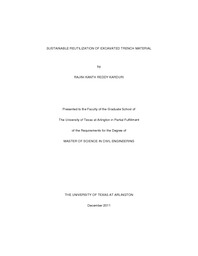
ATTENTION: The works hosted here are being migrated to a new repository that will consolidate resources, improve discoverability, and better show UTA's research impact on the global community. We will update authors as the migration progresses. Please see MavMatrix for more information.
Show simple item record
| dc.contributor.author | Karduri, Rajini Kanth Reddy | en_US |
| dc.date.accessioned | 2012-04-11T20:56:25Z | |
| dc.date.available | 2012-04-11T20:56:25Z | |
| dc.date.issued | 2012-04-11 | |
| dc.date.submitted | January 2011 | en_US |
| dc.identifier.other | DISS-11461 | en_US |
| dc.identifier.uri | http://hdl.handle.net/10106/9584 | |
| dc.description.abstract | Sustainability is becoming a key factor in most construction projects. In most construction projects, personnel are spending efforts to understand the social, economic and environmental impacts of the various facets of construction projects. Geotechnical engineering can contribute to the sustainability of the project via selecting sustainable materials and construction processes that would to lead several tangible benefits. For example a pipeline generally runs through a long and varying terrain which results in innumerable environmental impacts during a pipeline installation. Therefore, it is necessary for the design engineer and also the owner to estimate these impacts of pipe installation and evaluate various methods to minimize them. As a part of the pipeline layout and construction, large amounts of soil will be excavated during the pipeline installation process. Similarly, large amounts of soil need to be imported for bedding and backfilling of the trench. Both importing new fill material and exporting excavated trench material for landfilling will have serious implications on both the economic and environmental aspects of the construction project.The main focus of this research is to study and investigate the reutilization of excavated trench material for various applications including pipe backfills. For this purpose, Integrated Pipeline (IPL) project which is a joint effort between the Tarrant Regional Water District (TRWD) and Dallas Water Utilities (DWU) that will bring additional water supplies to the Dallas/Fort Worth metroplex is considered in this research. Soil samples were collected along the pipeline alignment and comprehensive geotechnical characterization studies including estimation of expansive clay minerals are attempted. Based on these studies, the sampling materials are identified for potential reuse as backfill, bedding and haunch materials. Economic and environmental benefits of the suggested reuse method of using insitu excavated material versus imported material were also evaluated. To quantify these benefits, a hypothetical section of a pipeline is assumed and both Cost and Carbon footprint analyses were performed on this section. Two different scenarios were considered in this research; one scenario used insitu treated excavated material for bedding and haunch layers while the second scenario used imported material for the same. This analysis showed a difference of more than 100% savings in carbon emissions when insitu treated excavated material is used instead of importing material. The hypothetical section assumed gives an idea of how carbon footprint analysis and cost analysis may be performed and briefly highlights the relative merits. | en_US |
| dc.description.sponsorship | Puppala, Anand | en_US |
| dc.language.iso | en | en_US |
| dc.publisher | Civil & Environmental Engineering | en_US |
| dc.title | Sustainable Reutilization Of Excavated Trench Material | en_US |
| dc.type | M.S. | en_US |
| dc.contributor.committeeChair | Puppala, Anand | en_US |
| dc.degree.department | Civil & Environmental Engineering | en_US |
| dc.degree.discipline | Civil & Environmental Engineering | en_US |
| dc.degree.grantor | University of Texas at Arlington | en_US |
| dc.degree.level | masters | en_US |
| dc.degree.name | M.S. | en_US |
Files in this item
- Name:
- Karduri_uta_2502M_11461.pdf
- Size:
- 3.465Mb
- Format:
- PDF
This item appears in the following Collection(s)
Show simple item record


